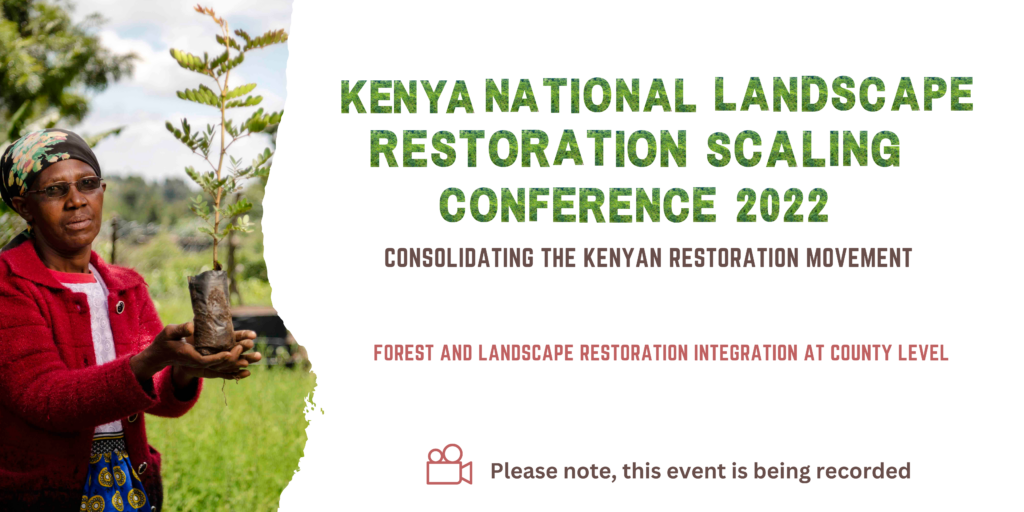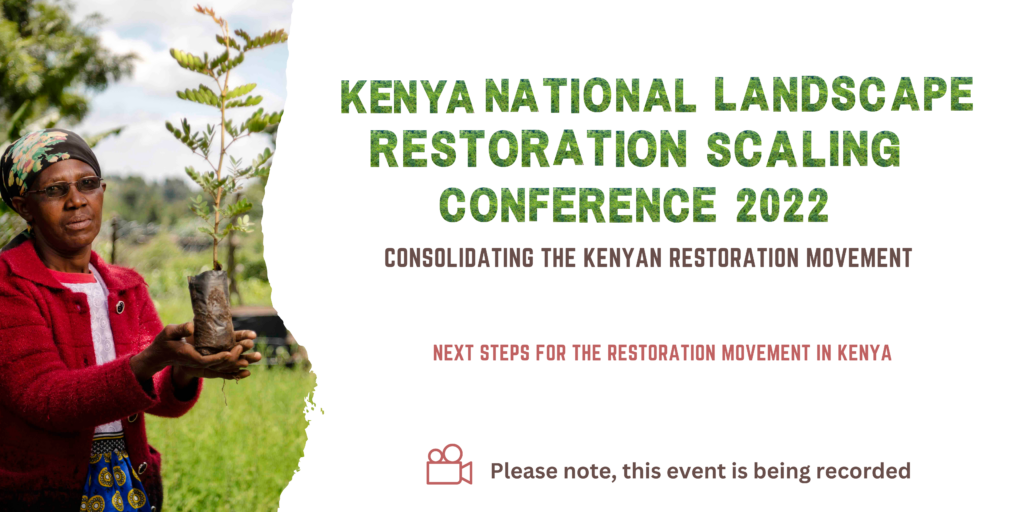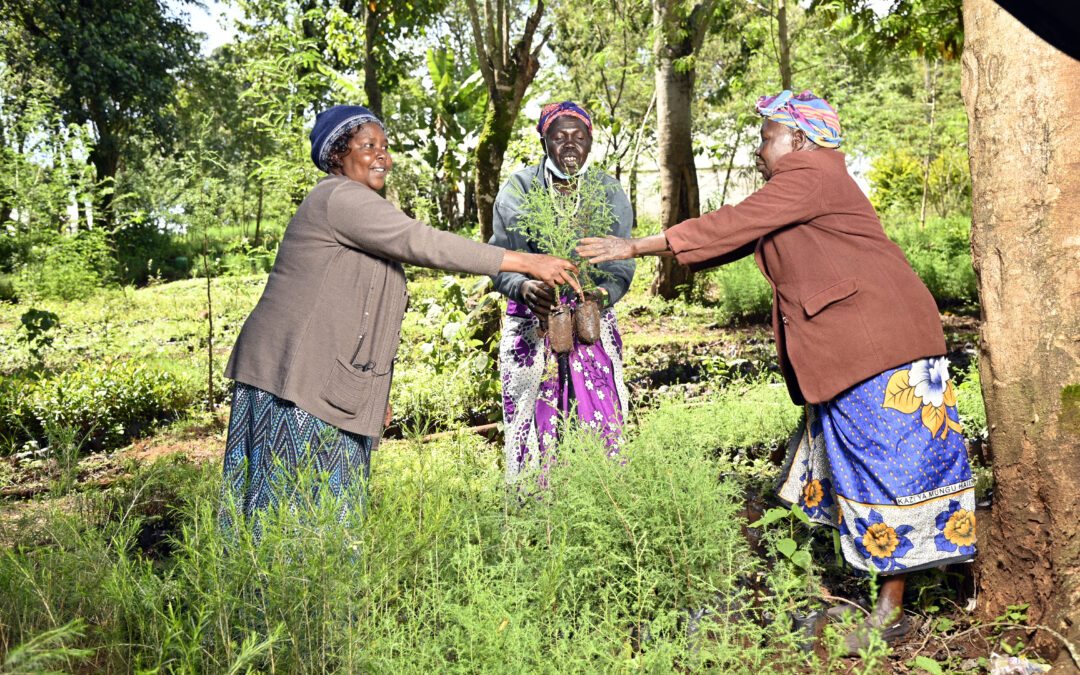By Marion Aluoch
The Kenya National Landscape Restoration Scaling Conference 2022 brought together stakeholders to take stock of the progress achieved since the 2021 conference as well as to chart a way forward. The conference highlighted the Kenyan restoration movement, assessed the progress made towards achieving the agreed-upon action plans from the 2021 conference, and solicited agreement and commitments from actors in the restoration space.

The conference took place on the 24th and 25th November 2022 under the theme of “Consolidating the Kenyan Restoration Movement.” The two-day conference focused on Forest Landscape Restoration (FLR) integration at the County level and the restoration movement’s next steps. The first day of the conference focused on Kenyan government initiatives to integrate FLR at the county level, particularly the national campaign for achieving and maintaining over 30% Tree Cover by 2032 – a special presidential program presented by Mr Alfred Gichu (Head, Directorate of Forest Conservation; National REDD+ Coordinator and Focal Point, Ministry of Environment, Climate change and Forestry) and the Forest and Landscape Restoration Implementation Plan (FOLAREP).
“Increasing tree cover and addressing land degradation is the foundation for the success of other productive sectors e.g., agriculture, tourism, manufacturing and energy. The achievement of these goals requires a government and whole society approach.”
Alfred Gichu – Head; Directorate of Forest Conservation, Directorate of Forest Conservation; National REDD+ Coordinator and Focal Point, Ministry of Environment, Climate change and Forestry
H.E Mutahi Kahiga, the Governor of Nyeri County, emphasized the importance of landscape restoration urging participants to restore landscapes as a means of improving the resilience of their communities’ livelihoods and improving food security.
“Let us ensure that we create livelihoods for our most vulnerable communities, increase food security, enhance quality of living through improved environments and honor God by restoring our land,“
H.E Mutahi Kahiga, Nyeri County Governor.
Several examples of how various counties are integrating FLR were also presented. Mr. Brian Muthoka, Senior Programme Officer, Water, Forestry, and Natural Resource Management Committee, moderated a panel discussion in which various county directors discussed landscape restoration ambitions, integration in County Integrated Development Plans (CIDPs), and the challenges and opportunities for further scaling and impact.
County governments are at the forefront of ensuring that FOLAREP becomes a success. They are doing this by; laying down legal structures to support restoration, integrating Forest and Land restoration into their County Integrated Development Plans and setting restoration targets. For example, Vihiga county has committed to the most ambitious restoration plan. It has pledged to restore the Maragoli Hills Forest and expand the county’s school greening program in order to achieve 51% forest cover by 2027.
Moving forward, the counties committed to creating conducive policy and legal environments for restoration targets and coordinating their efforts with those of the national government. This will include domesticating FOLAREP by incorporating it into their CIDPs. Community participation in restoration projects will be equally important, as the majority of the land designated for restoration is private property.
The second day of the conference focused on defining the next steps for the restoration movement in Kenya. This was an excellent opportunity for the stakeholders present to engage and propose incentives for mobilizing additional finance for landscape restoration efforts, particularly efforts by communities, women, youth and the private sector. Action groups that are at the core of the restoration movement, as well as other organisations, demonstrated their commitments and future plans for the group. It was also an opportunity for the Regreening Africa Programme and the African Forest Landscape Restoration Initiative (AFR 100) to share lessons learned and opportunities for the future.

A panel discussion with representatives from various organisations reflected on the available opportunities to advance the restoration movement. Several opportunities for leveraging were discussed during the panel discussion, including integrating research into restoration efforts to support the movement, attracting more investment for restoration by demonstrating why it is attractive and supporting emerging investment opportunities, and leveraging on the restoration of rangelands and croplands to meet Kenya’s restoration targets.
Dr. Christopher Wanga then brought the conference to a close on behalf of Hon. Harry Kimutai, Principal Secretary, State Department of Livestock. Dr. Wanga reaffirmed the government’s commitment to land restoration, citing national, regional, and international targets. He also emphasize the ministry’s involvement in supporting the restoration movement, both through the various action groups formed as a result of the conference and through active participation.
“The Ministry is involved with various action groups that resulted from the conference and is part of this movement. These are the Landscape Restoration Monitoring Technical Working Group that has successfully developed a National Forest and Landscape Restoration Monitoring Framework.”
Dr. Christopher Wanga – State Department of Livestock.
In the run-up to the main conference, a series of four pre-conference thematic webinars were held to provide a space for further discussion of the themes and to build momentum for the conference. The Finance Options for Restoration webinar showcased and explored various financing options available to youth, women, and faith actors to support their restoration initiatives. The webinar on accelerating restoration action through youth and women highlighted lessons learned from the participation of youth, children, and women. This included showcasing models or approaches for involving youth, children, and women in restoration efforts. The Power of Faith-Based Approaches to Landscape Restoration in Kenya provided a platform for several faith actors to showcase their restoration initiatives, motivation to participate in restoration, challenges encountered, lessons learned, opportunities, and needed support. The pre-conference thematic webinar on restoring Kenya’s rangeland: the way forward presented the results of a discussion on key issues and challenges identified to influence rangeland restoration and conservation in Kenya.
For more information on the conference, including the conference report and resources please follow this link.
This story was produced with the financial support of the European Union. Its contents are the sole responsibility of Regreening Africa and do not necessarily reflect the views of the European Union.

